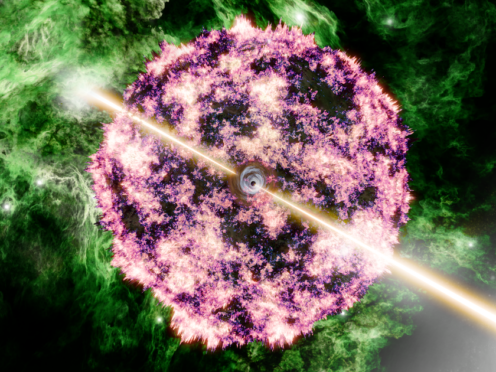The collapse of a massive star may have caused the brightest cosmic explosion of all time, astronomers have said.
The luminous burst of light, which occurred more than two billion light years from Earth and lasted mere seconds, was so bright that it was said to have blinded space instruments.
Scientists said this type of event is a gamma-ray burst (GRB), known for being some of the strongest and brightest explosions in the universe.
However this GRB, dubbed GRB 221009A, was deemed so exceptional that astronomers said it was the brightest of all time (Boat) since the beginning of human civilisation.
Now an international team of scientists analysed data from Nasa’s James Webb Space Telescope (JWST).
The findings, published in the journal Nature Astronomy, suggest Boat’s likely origin is an explosion, or supernova, that came after the collapse of a massive star.
It is believed supernovas produce heavy elements such as platinum and gold, but when the researchers looked, they found no evidence of these precious metals, also raising fresh questions about how they came into existence.
Dr Peter Blanchard, of Northwestern University in the US who led the study, said: “When we confirmed that the GRB was generated by the collapse of a massive star, that gave us the opportunity to test a hypothesis for how some of the heaviest elements in the universe are formed.
“We did not see signatures of these heavy elements, suggesting that extremely energetic GRBs like the Boat do not produce these elements.
“That doesn’t mean that all GRBs do not produce them, but it’s a key piece of information as we continue to understand where these heavy elements come from.
“Future observations with JWST will determine if the Boat’s ‘normal’ cousins produce these elements.”
The researchers also found that this supernova, unlike the associated Boat, was not itself especially luminous.
Dr Blanchard said: “You might expect that the same collapsing star producing a very energetic and bright gamma-ray burst would also produce a very energetic and bright supernova.
“But it turns out that’s not the case.”
The astronomers said Boat is 10 times or more brighter than any ever seen and an event like this occurs once every 10,000 years.
Dr Blanchard said: “We are fortunate to live in a time when we have the technology to detect these bursts happening across the universe.
“It’s so exciting to observe such a rare astronomical phenomenon as the Boat and work to understand the physics behind this exceptional event.”
The researchers still do not know why Boat was so bright but one theory is that the very powerful jets of plasma that were released after the outburst might play a role.
Tanmoy Laskar, an assistant professor of physics and astronomy at the University of Utah and a study co-author, said: “It’s like focusing a flashlight’s beam into a narrow column, as opposed to a broad beam that washes across a whole wall.
“In fact, this was one of the narrowest jets seen for a gamma-ray burst so far, which gives us a hint as to why the afterglow appeared as bright as it did.
“There may be other factors responsible as well, a question that researchers will be studying for years to come.”
